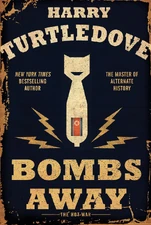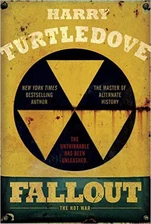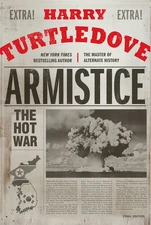TR (Message Wall | contribs) Tag: rte-source |
TR (Message Wall | contribs) Tag: rte-source |
||
| Line 77: | Line 77: | ||
==References== |
==References== |
||
| − | {{Reflist| |
+ | {{Reflist|20em}} |
{{The Hot War}} |
{{The Hot War}} |
||
Revision as of 00:11, 1 December 2015
This article is about World War III found in the series The Hot War. For other versions of World War III, see Third World War (disambiguation).
| World War III | |||||||||
|---|---|---|---|---|---|---|---|---|---|
|
|||||||||
| Belligerents | |||||||||
| * | * |
||||||||
World War III was a war between the United States and its allies in NATO, and the Soviet Union and its satellites. While the war had its roots in the Korean War, which began in June, 1950, the immediate trigger for direct conflict between the U.S. and the U.S.S.R. came in January, 1951.
Prelude: The Korean War and China (November 1950-January 1951)
Arguably, the first step towards World War III came in June, 1950, when North Korea invaded South Korea. While North Korean forces managed to drive far into South Korean territory in its initial surprise attack, UN forces, under the command of U.S. general Douglas MacArthur, had succeeded in pushing the North Koreans back, and had even driven up towards the Chinese border.[1]
However, the next tentative step towards a global war came in November, 1950, when, despite an number of hints that were effectively ignored by MacArthur, Chinese troops crossed the Yalu River and came to Kim Il-sung's aid. In late November and into December, the Chinese forces thoroughly destroyed three divisions of American forces between the Chosin Reservoir and Hungnam, the worst defeat American forces had seen since the Battle of Bataan during World War II.[2]
On December 18, 1950, U.S. President Harry Truman flew to Honolulu on December 18, 1950 to meet with General MacArthur. While MacArthur didn't quite admit he'd been wrong when he assured Truman that the Chinese would not intervene, he did acknowledge that they were attacking and would continue to mass along the Yalu River until China itself was attacked. When Truman pointed out that B-29s weren't doing as well during this was as they had during World War II, MacArthur suggested atomic weapons might make the difference if they were used on cities in Manchuria to disrupt the Chinese supply line.
Truman then wondered if Joseph Stalin and the Soviet Union would retaliate against U.S. allies should the U.S. bomb Manchuria. (At this point, the Soviet Union's role in the Korean War was limited to Soviets piloting MiGs on behalf of North Korea.) MacArthur dismissed these concerns, arguing that the USSR did not have sufficient atomic weapons to do so. He also argued that U.S. atomic weapons could be used in the case of a Soviet invasion of West Germany. Despite his misgivings, Truman agreed to the use of atomic weapons. Truman admitted that if the three divisions in North Korea has been successfully evacuated from Hungnam, he would not have considered the atomic option.[3]
In January, 1951, pits were delivered to Korea and installed in all weapons already present.[4] A few weeks later, Truman transferred the final decision making to MacArthur, authorizing the general to use them if, in MacArthur's view, their use was the only way to improve the situation. The situation had certainly worsened, as the Chinese had relentlessly marched south throughout December and into January, recapturing Seoul, the South Korean capital.[5] In the meantime, U.S. aerial reconnaissance showed that the Soviets were moving fighters and bombers onto airstrips in southeastern Siberia.[6]
Atomic Bombings and the Soviet Mobilization (January-February, 1951)
The decision finally came a few weeks later. On January 23, 1951, the U.S. dropped several bombs on strategic points in Manchuria.[7] Within hours, Truman appeared before the country explaining the action and his reasons for approving it. He also emphasized that Soviet territory had not been attacked.[8] Despite his assurances that the US had no quarrel with the USSR, Joseph Stalin retaliated on behalf of his ally, China, and ordered six atomic attacks against U.S. allies staged from Pechenga[9]: Aberdeen and Norwich in the United Kingdom; Nancy and Rouen in France, and; Augsburg and Bremen in West Germany.[10] The Soviet army headed west as the bombs were landing in Europe, as did the armies of its allies: Poland, Hungary, Romania, and Czechoslovakia.[11]
The attacks on Britain and France effectively triggered the NATO treaty. British Prime Minister Clement Attlee and French President Vincent Auriol immediately demanded the U.S. respond. So did West Germany, but as that country wasn't in NATO, Truman felt comfortable ignoring them.[12] Truman consulted with Secretary of Defense George Marshall. While neither were enthusiastic about attacking the Soviets again, Truman decided that destroying Pechenga was the least terrible option, as it might mollify Britain and France, and was sufficiently isolated from more populous Soviet territory that Stalin might not feel compelled to respond. Ignoring the European attacks might end NATO altogether and send Europe into an alliance with Stalin. At Marshall's suggestion, Truman had the planes fly out of the UK and France. He also ordered Alaska put on alert, as it was similar to Pechenga, and would be a likely target if Stalin did retaliate.[13]
Pechenga was destroyed on February 4, 1951. Despite Truman's order for precautions, Elmendorf Air Force Base was destroyed by the Soviets on February 7.[14]
European Theater
Ground War in Europe and Continued Atomic Bombings (February 1951)
In response, on February 15, Truman authorized atomic attacks against Russia's satellites, destroying Zywiec in Poland, Szekesfehervar in Hungary, and Ceske Budejovice in Czechoslovakia in an effort to disrupt several transportation hubs.[15] Two days later, the Soviet invasion of West Germany began, and World War III was now past the point of no return.[16]
The Soviets, using their numerical superiority, made substantial gains in West Germany, Austria and northeastern Italy, despite huge casualties inflicted on them by Allied forces.[17] In response, on February 24, U.S. launching bombing raids against various targets within the USSR and its allied countries, including Warsaw and Krakow in Poland, Prague and Bratislava in Czechoslovakia, and Budapest in Hungary, and the Soviet cities of Leningrad and Vladivostok, as well as Minsk in Byelorussian SSR and Rovno in the Ukranian SSR. Allegedly, the Leningrad attack (a night raid) killed several children playing in a park for which Stalin promised retribution.[18]
As February wound down, NATO was faced with a catastrophe. Truman realized that the U.S. probably didn't have the manpower to stop the Russians, even with Britain and France contributing. He was already regretting the decision to bomb Manchuria, especially as the only solution he and Secretary of Defense Marshall could see to remedy the disparity in manpower was the use of more atom bombs.[19] However, as West German Chancellor Konrad Adenauer had wired Truman and begged him not to use atom bombs in West German territory, lest the U.S. lose West Germany as an ally, Truman ruled it out, despite Marshall's misgivings. Instead, Truman decided to use bombs in East Germany and in Russia's satellites with the goal of slowing down the Soviet supply line. He even hoped that the attacks might prompt the governments of the various satellites to reconsider their alliance with Russia, or to prompt the citizens of those states to rebel against their communist governments.[20]
Truman further decided not to attack capital cities, but instead smaller towns that had important rail lines. Marshall prepared a list for Truman's approval.[21]
The Soviet Attack on North America and the Global Response (March, 1951)
While the atomic attacks did disrupt Soviet supply lines and slow down the drive west, they did not cause any uprisings.[22] They also resulted in the most audacious attacks from the Soviets to date. On the night of March 1-2, Soviet Tu-4s, painted to look like the American B-29s they'd been reverse engineered from, dropped several atomic bombs on the American west, including the cities of Seattle, Portland, Los Angeles, San Francisco, Salt Lake City and Denver.[23] On the East Coast, Bangor, Maine and a location in Newfoundland were also attacked.[24] Bombers meant for Spokane and Las Vegas were successfully downed by the U.S.[25] Moreover, only one bomber crew actually made it back to the Soviet Union,[26] with the rest having to land on nearby air fields and surrender[27], and others having to bail out near the cities they'd just bombed and being subjected to civilian vengeance (in violation of the Geneva Conventions.[28]
In response, the U.S. destroyed a number of Soviet ports on March 4, including Vladivostok[29] (a successful if costly attack for the U.S.), as well as Kiev,[30]. In the following weeks, the U.S. also dropped atomic bombs on Leningrad[31] and Moscow itself.[32] Stalin survived this attack, and took to the radio to rally the Soviet Union.[33]By the end of March Allied forces were in constant retreat in Germany, as the Soviets pressed west.[34] Kuibishev became the de facto capital of the Soviet Union.[35]
Soviet Gains in Europe (April-June 1951)
In April, the Soviet Union attacked several airfields in the U.K. with conventional explosives, including USAF barracks at Sculthorpe. While the attacks killed several and did a fair amount of damage, compared with an atomic bomb, the attacks were perceived as comparative nuisances.[36] However, days later, the Soviets inflicted another atomic attack on the U.S. and the U.K. when it successfully placed an atom bomb in freighters, and successfully detonated those bombs in the Panama Canal and the Suez Canal. These attacks helped hamstring NATO's logistics.[37] At the end of the month, the USSR struck another blow against NATO by dropping an atomic bomb on Bordeaux, France, which had been a major shipping hub for the U.S.[38] They also succeeded in taking Milan, Italy on April 30, 1951.[39]
In May, thee U.S. was able to destroy Khabarovsk and Blagoveshchensk, two key Soviet cities on the Trans-Siberian railroad; the attacks were designed to hamper Soviet aid to its allies in Korea.[40] However, at the close of the month, the Soviets had taken Dortmund, in the heart of the Ruhr.[41] In June, the Soviets inflicted another blow on beleaguered France when it dropped an atomic bomb on the center of Paris.[42]
Korean Theater (January-June, 1951)
Ironically, once the war in Europe began, the Korean theater became a lower priority for the U.S. and the Soviets, although Chinese and North Korean troops continued to press south, with the Korean War looking more and more like World War I.[43] Nonetheless, the U.S. military was able to deliver a regiment's worth of Pershing tanks in advance of an attack near Chongju. The battle proved to be a success for the UN.[44] Another engagement in April saw UN forces hold back a column of T-34s until air support could do enough damage to force a retreat.[45]
In April, 1951, theUnited States launched a substantial bombing raid against Pyongyang, the North Korean capital, in an effort to kill Kim Il-sung The attack used conventional explosives, rather than atomic weapons. Kim survived, as Pyongyang was heavily defended. Nonetheless, the attack did a fair amount of damage.[46] However, that very same evening, communist forces were able to bomb a U.S. air strip near Pusan.[47]
After those events, the war quieted down, with both sides blaring propaganda at each other over loudspeakers, with Red troops actually surrendering every so often, thanks in part to a message created by a psy-ops colonel named Linebarger, which used the Chinese words for "love" and "virtue" and "humanity", which when taken together also sounded like the English words for "I surrender", allowing the Reds to surrender without losing face.[48]
The month of May saw the snow melt, and an increase in shelling attacks from the Chinese. Curtis was painfully aware of the long logistics chain between Korea and the U.S. after the attacks on the U.S. west coast, and the Panama and Suez Canals.[49] While many hoped that the U.S. atomic attacks on Khabarovsk and Blagoveshchensk, would lead to a slowdown of the supplies coming into the Chinese and North Korean armies, others had doubts.[50]
- This article or subsection is a stub because the work is part of a larger, as-of-yet incomplete series.
References
- ↑ Bombs Away, see, eg., pg. 7, ebook.
- ↑ Bombs Away, pg. 5, ebook.
- ↑ Ibid., pgs. 5-9.
- ↑ Ibid., pg. 25.
- ↑ Ibid., pg. 38.
- ↑ Ibid., pgs. 40-41.
- ↑ Ibid., pgs. 55-61.
- ↑ Ibid., pgs. 58-61.
- ↑ Ibid., pg. 86.
- ↑ Ibid., pgs. 64-65, 70.
- ↑ Ibid, pg. 67.
- ↑ Ibid., pg. 86.
- ↑ Ibid., pgs. 87-90.
- ↑ Ibid., pg. 93.
- ↑ Ibid., pg. 104.
- ↑ Ibid., pgs. 110-118.
- ↑ Ibid., pg. 134.
- ↑ Ibid., pgs. 120-121.
- ↑ Ibid., pgs. 133-134.
- ↑ Ibid., pgs. 135-137.
- ↑ Ibid., pg. 138.
- ↑ Ibid., pg. 138-140.
- ↑ Ibid. pgs. 141-150.
- ↑ Ibid., pg. 159.
- ↑ Ibid. pg. 165.
- ↑ Ibid., pgs. 214-215.
- ↑ Ibid., pgs. 164-165.
- ↑ Ibid., pgs. 171-172.
- ↑ Ibid., pg. 165.
- ↑ Ibid., pg. 162.
- ↑ Ibid. pg. 183.
- ↑ Ibid. pg. 178.
- ↑ Ibid. pgs. 178-179.
- ↑ Ibid., pgs. 192-196.
- ↑ Ibid., pg. 214.
- ↑ Ibid., pgs. 278-280.
- ↑ Ibid., pgs. 291-294.
- ↑ Ibid., pgs. 309-311.
- ↑ Ibid., pg. 329.
- ↑ Ibid., pgs. 372-376.
- ↑ Ibid., pg. 394.
- ↑ Ibid., pgs. 427-430.
- ↑ Ibid.
- ↑ Ibid., pg. 204-205.
- ↑ Ibid., pgs. 273-277.
- ↑ Ibid., pgs. 283-287.
- ↑ Ibid., pgs. 286-287.
- ↑ Ibid., pgs. 311-315.
- ↑ Ibid., pgs. 357-360.
- ↑ Ibid., pg. 382.
| |||||||||||||||||||||


